In today’s fast-paced world, grooming and aesthetics have become an essential part of daily life for many individuals. One common concern is the unwanted body or facial hair that can be challenging to manage with traditional methods such as shaving, waxing, or threading. Laser hair reduction has emerged as a popular, long-term solution for smooth, hair-free skin.
If you’re considering laser hair reduction but still have questions about how it works, the benefits, risks, and what to expect from the procedure, this comprehensive guide will walk you through everything you need to know.
What is Laser Hair Reduction?
Laser hair reduction is a cosmetic procedure that uses focused light beams to reduce unwanted hair from various parts of the body. Unlike temporary hair removal methods such as waxing or shaving, laser hair reduction targets the hair follicle, which helps prevent future hair growth. Over time, the treatment can lead to permanent hair reduction.
It’s important to note that while laser treatment reduces hair growth significantly, it may not completely eliminate all hair. Hair grows in cycles, and laser treatment is most effective on active hair follicles, which is why multiple sessions are needed.
How Does Laser Hair Reduction Work?
Laser hair reduction works through a process called selective photothermolysis. This involves the precise targeting of the hair follicles by laser light that is absorbed by melanin (the pigment in the hair). The absorbed light energy converts into heat, damaging the hair follicle and preventing or delaying future growth.
Here’s a step-by-step breakdown of the process:
- Melanin Absorption: The laser targets the pigment (melanin) in the hair shaft. People with dark, coarse hair tend to respond better because their hair contains more melanin to absorb the light.
- Follicle Destruction: As the melanin absorbs the laser’s heat energy, it heats up the hair follicle to the point where it damages or destroys it, preventing further hair growth.
- Growth Cycle Considerations: Hair grows in different phases: the anagen (growth), catagen (transition), and telogen (resting) phases. Laser treatments are most effective during the anagen phase because this is when the hair is attached to the follicle. Since not all hair is in this phase at once, multiple sessions are necessary to treat each follicle during its anagen phase.
Benefits of Laser Hair Reduction
Laser hair reduction offers numerous advantages over traditional methods of hair removal:
- Long-Term Solution: While results vary from person to person, many people experience long-lasting hair reduction after several sessions. Over time, any regrowth tends to be finer and lighter.
- Precision: Lasers can selectively target dark, coarse hairs without damaging the surrounding skin, making it a precise and effective treatment.
- Speed: Each laser pulse takes only a fraction of a second and can treat many hairs simultaneously. Small areas like the upper lip can be treated in less than a minute, while larger areas like the back or legs may take an hour or two.
- Less Painful: Compared to waxing or epilation, laser hair reduction tends to be less painful. Many describe the sensation as similar to a rubber band snapping against the skin, and cooling mechanisms on modern lasers make the experience more comfortable.
- Suitable for All Body Parts: Laser hair reduction can be performed on any part of the body, including sensitive areas like the face, bikini line, and underarms.
Who Can Get Laser Hair Reduction?
Laser hair reduction is safe for most people, but certain factors determine how effective it will be:
- Skin and Hair Type: People with lighter skin and darker hair tend to see the best results because the laser can more easily differentiate between the skin and the hair pigment. However, advancements in laser technology have made it possible for individuals with darker skin tones to achieve effective results as well. Modern lasers such as the Ndare designed for treating a broader range of skin types.
- Hair Color: Since the laser targets the melanin in the hair, it is less effective on blonde, red, or grey hair, which contains less pigment.
- Medical Conditions: Certain medical conditions, such as hormonal imbalances or polycystic ovary syndrome (PCOS), may affect hair growth and potentially impact the effectiveness of laser treatment.
- Pregnancy: It is generally advised to avoid laser hair reduction during pregnancy, as the hormonal changes can affect hair growth patterns, and there are no definitive studies to prove its safety for pregnant women.
Laser Hair Reduction Treatment Areas
Laser hair reduction is versatile and can be used to target a wide variety of areas, including:
- Face: Upper lip, chin, cheeks, and sideburns
- Legs: Full legs or half-legs
- Arms: Full arms or forearms
- Bikini Line: Removes hair from around the bikini area
- Underarms: A popular choice for its convenience
- Back and Chest: Especially common for men
The treatment can be customized to your specific needs and preferences, whether you’re looking to reduce hair in a single area or multiple areas.
What to Expect During the Procedure
Before starting your laser hair reduction journey, it’s essential to know what to expect during the procedure:
- Consultation: Before undergoing laser hair reduction, you will typically have a consultation with a dermatologist or certified technician to discuss your goals, review your medical history, and evaluate your skin and hair type.
- Preparation: Prior to your treatment, you may be asked to avoid sun exposure and tanning for a few weeks. You should also avoid plucking, waxing, or using hair removal creams that disrupt the hair follicle before treatment. Shaving, however, is allowed since it leaves the hair root intact.
- During the Procedure: During the treatment, the laser device will be applied to your skin. Depending on the area being treated, a cooling device or gel may be used to protect your skin and enhance comfort. The sensation is often described as a slight prickling or stinging, though pain tolerance varies.
- Post-Treatment: After the session, you may experience slight redness or swelling in the treated area, similar to a mild sunburn. This usually subsides within a few hours to a couple of days. Your dermatologist may recommend soothing creams and sunscreen to protect the treated area.
Risks and Side Effects of Laser Hair Reduction
While laser hair reduction is considered safe, there are some potential side effects to be aware of:
- Skin Irritation: Temporary discomfort, redness, and swelling are common immediately after the procedure but typically subside within a few hours or days.
- Pigmentation Changes: Some people may experience temporary pigment changes, such as darkening (hyperpigmentation) or lightening (hypopigmentation) of the skin. This risk is higher for people with darker skin tones, but the use of the right laser type and settings can minimize the risk.
- Scarring or Burns: Though rare, improper technique or use of incorrect laser settings can lead to scarring or burns. This is why it is crucial to have the procedure done by a qualified and experienced professional.
How Many Sessions Are Needed?
Laser hair reduction is not a one-time treatment. Multiple sessions are necessary for optimal results, usually spaced 4 to 6 weeks apart, depending on the treatment area and your individual hair growth cycle. On average, patients require 6 to 8 sessions to achieve the desired level of hair reduction, although this can vary.
Preparing for Your Laser Hair Reduction Treatment
Here are some tips to ensure you are well-prepared for your treatment:
- Shave the Area: Shave the area you’re treating a day before your appointment. This allows the laser to focus on the hair follicle without burning the hair above the skin.
- Avoid Sun Exposure: Stay out of the sun and avoid tanning beds for at least two weeks prior to treatment. Sun exposure can increase the risk of complications and interfere with the effectiveness of the laser.
- Skip Other Hair Removal Methods: Avoid plucking, waxing, or bleaching the hair in the treatment area for at least four weeks before your session. These methods remove the hair from the follicle, which is necessary for the laser to work effectively.
Conclusion
Laser hair reduction is a safe, effective, and long-term solution for managing unwanted hair. With advancements in laser technology, the procedure is now accessible to a wider range of skin tones and hair types, offering a tailored approach for each individual. While it requires multiple sessions and maintenance treatments, the benefits of smoother, hair-free skin without the hassle of regular waxing or shaving make it an attractive option.
If you’re considering laser hair reduction, consult with a licensed and experienced provider to assess your suitability for the treatment and create a personalized plan that meets your aesthetic goals.
For Consultation Contact us on 9158681123
Website – www.chetnahospital.co.in
Address – Chetna Hospital, Sambhajinagar, MIDC, G Block, Near Rotary Club, Chinchwad 411019
.
.
.
#hospital#pune#pcmc#chinchwad#health#healthcare#skin#dermatologist#skinspecialist#skinclinic#hairdermatologist#skindoctor#dermatologistappointment#skincareprofessional#derma#skindr#gfctreatment#hairloss#hairlosstreatment#hairgrowth#hairfalltreatment#hairfallsolution













